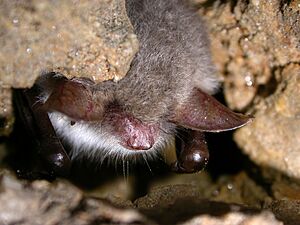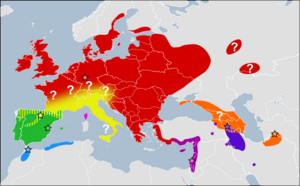Natterer's bat facts for kids
Quick facts for kids Natterer's bat |
|
|---|---|
 |
|
| Conservation status | |
| Scientific classification | |
| Genus: |
Myotis
|
| Species: |
nattereri
|
The Natterer's bat (Myotis nattereri) is a type of bat found across much of Europe, parts of the Near East, and North Africa. It has pale wings and brown fur that becomes grayish-white on its belly. These bats are known for eating insects and other small creatures. They catch their food while flying or by chasing it on the ground.
In summer, Natterer's bats often rest in deciduous or coniferous trees, buildings, or special bat boxes. These spots are usually close to where they hunt for food. When winter comes, they hibernate (sleep deeply) in caves, tunnels, old mines, or cellars. They often hide in small cracks and spaces. This bat was first described in 1817 by Heinrich Kuhl. He named it after the Austrian naturalist Johann Natterer.
Contents
What Natterer's Bats Look Like
Natterer's bat is a medium-sized bat. Its head and body are about 1.75 to 2 inches (4.4 to 5.1 cm) long. Its forearm, from elbow to wrist, is about 1.75 inches (4.4 cm) long. This bat usually weighs between 5 and 9.5 grams.
The fur on its back and head is a grayish-brown color. The fur on its belly is whitish-grey. Its ears and wing membranes are smoky grey. You can tell this bat apart from similar species by a special feature. The edge of the membrane between its back legs has wrinkles. It also has stiff, curved hairs along this edge. The small spur of cartilage that supports this membrane is shaped like an "S".
Where Natterer's Bats Live
Natterer's bats are found in many places across the western Palaearctic region. This includes most of Europe, parts of the Middle East, and northern Africa. Their range stretches from southern Sweden, Finland, and western Russia in the north. To the west, they are found in Ireland, the United Kingdom, Spain, and Portugal.
They live as far east as Ukraine, western Asia Minor, the Levant, and the Caucasus region. You can also find them in the Kopet Dag Mountains in Turkmenistan, Iran, and northern Kazakhstan. Their southern limit is Morocco and Algeria, reaching as far as the Atlas Mountains. There are not many records from North Africa, so the population there is likely small. They used to live in Norway, but they might not be there anymore.
These bats can live from sea level up to about 2,000 meters (6,600 ft) high. They prefer forests, parkland, and open areas with scattered trees. They often rest in holes in trees, buildings, and special bat boxes. In winter, they hibernate in caves, old mineshafts, tunnels, and cellars. They hide in cracks and crevices, usually near the entrance of these places. Natterer's bats usually stay in the same area. Their summer resting spots and winter hibernation sites are often within 120 kilometers (75 miles) of each other.
How Natterer's Bats Behave
Natterer's bats are active at night (nocturnal) and eat insects (insectivorous). They come out at dusk to hunt for food. They use echolocation to find prey and navigate in the dark. Like many bats, they make sounds that are too high-pitched for most humans to hear. Then, they listen to the echoes that bounce back. This helps them create a "sound picture" of their surroundings.
The sounds these bats use for echolocation are between 23 and 115 kilohertz (kHz). Most of their sound energy is at 53 kHz. Each sound signal lasts about 3.8 milliseconds. The wide range of frequencies in their sounds helps them find prey just a few centimeters away from plants. They do not use their eyesight, smell, or sounds from their prey to hunt. The bat catches insects while flying. They mostly catch bugs in the air. But they can also eat creatures like spiders and caterpillars that hang near leaves on silk threads.
Studies of their droppings show that Natterer's bats can also pick up food from the ground. Their diet mostly includes large flies (Diptera). They also commonly eat caddisflies (Trichoptera), bees, wasps, ants, hoverflies (Hymenoptera), and spiders and harvestmen (Arachnida). Sometimes, their droppings contain remains of moths (Lepidoptera), beetles (Coleoptera), bugs (Hemiptera), earwigs (Dermaptera), and centipedes (Chilopoda). This bat might use the membrane between its back legs to catch prey. The fringing hairs on this membrane might help them sense things. They have been seen landing on the ground to pick up and chase invertebrates that are active at night. They keep making search sounds to find them precisely.
Reproduction and Life Cycle
Natterer's bats breed in the spring. Many female bats may gather together in a special nursery roost. After mating, a female usually gives birth to one baby bat. This happens after a pregnancy (gestation) of 50 to 60 days. Sometimes, twins are born. The baby bats stop drinking milk from their mother after six or seven weeks. Young bats become ready to have their own babies the following year.
Status and Protection
The IUCN (International Union for Conservation of Nature) has listed the Natterer's bat as "Least Concern" on its Red List of Threatened Species. This means they are not currently in danger of disappearing. They are found over a very large area and are common in many places. The number of Natterer's bats seems to be stable. No major threats have been found.
However, the IUCN does note some concerns. In some parts of their range, woodlands are being lost. Also, land management practices are changing. Resting places in trees and buildings might be destroyed. In Africa, cave habitats where bats rest are being damaged. Sadly, these bats are also used in traditional medicine practices in North Africa.
Natterer's bats are protected by several important agreements. These include the European Habitats Directive, the Bonn Convention (Eurobats), and the Berne Convention. In the United Kingdom, because they are rare, woodlands where they live might be made into special protected areas. These are called Sites of Special Scientific Interest or Special Areas of Conservation. Landowners might also get grants to help protect them.
See also
- Bokeloh Bat lyssavirus



